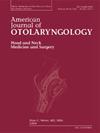甲状腺和甲状旁腺手术后阿片类药物处方:对北美外科医生的调查
IF 1.7
4区 医学
Q2 OTORHINOLARYNGOLOGY
引用次数: 0
摘要
目的甲状腺和甲状旁腺手术(TPS)后阿片类药物的过量处方仍然是一个问题。我们进行了一项横断面调查研究,以描述北美耳鼻喉头颈外科医生的阿片类药物处方趋势。方法对加拿大耳鼻喉头颈外科学会(CSO)或美国头颈外科学会(AHNS)会员的耳鼻喉头颈外科医生进行横断面调查研究。这项包含20个项目的自愿在线调查于2023年2月至2024年7月进行,涉及外科医生对TPS的镇痛实践。统计分析包括描述性方法、多变量logistic回归和卡方检验。结果共有153名外科医生完成了调查(应答率:22.6%),其中大多数是加拿大人,接受过奖学金培训,执业时间为0-10年。大多数外科医生(73%)认为术后患者疼痛为3-5/10。超过75%的外科医生为住院甲状腺手术患者开阿片类药物,早期职业外科医生更有可能开阿片类药物,而美国外科医生不太可能开阿片类药物。美国外科医生通常开羟考酮,而加拿大外科医生更喜欢开可待因。与美国外科医生相比,加拿大外科医生更有可能开出阿片类药物,特别是≥20片阿片类药物。几乎50%的外科医生开了10-19片阿片类药物,尽管预测术后患者可能只使用0-10片阿片类药物。结论鼻咽喉头颈外科医生通常会给TPS患者开阿片类药物,尽管他们发现患者只消耗了阿片类药物处方的一小部分。阿片类药物处方的标准化和促进多模式镇痛实践是减少阿片类药物过度处方的必要条件。本文章由计算机程序翻译,如有差异,请以英文原文为准。
Opioid prescribing after thyroid and parathyroid surgery: A survey of North American surgeons
Objectives
Opioid overprescribing remains an issue following thyroid and parathyroid surgery (TPS). We performed a cross-sectional survey study to describe opioid prescribing trends of otolaryngology–head and neck surgeons across North America.
Methods
We performed a cross-sectional survey study of otolaryngology–head and neck surgeons who are members of the Canadian Society of Otolaryngology–Head and Neck Surgery (CSO) or the American Head and Neck Society (AHNS). The voluntary 20-item online survey addressed surgeon analgesia practices for TPS and was distributed from February 2023–July 2024. Statistical analysis included descriptive methods, multivariable logistic regression, and Chi-square testing.
Results
Overall, 153 surgeons completed the survey (response rate: 22.6 %) and of these surgeons, most were Canadian, fellowship-trained, and practicing for 0–10 years. Most surgeons (73 %) rated postoperative patient pain as 3–5/10. Over 75 % of surgeons prescribed opioids for inpatient thyroid surgery with early-career surgeons more likely to prescribe opioids and US surgeons were less likely to prescribe opioids. Oxycodone was commonly prescribed by US surgeons and Canadian surgeons preferred codeine. Canadian surgeons were likelier to prescribe opioids, especially ≥20 opioid tabs, when compared to US surgeons. Almost 50 % of surgeons prescribed 10–19 opioid tabs despite predicting that postoperative patients likely only use 0–10 opioid tabs.
Conclusions
Otolaryngology–head and neck surgeons routinely prescribe opioids for TPS despite identifying that patients only consume a fraction of their opioid prescription. Standardization of opioid prescribing and promotion of multimodal analgesia practices are needed to reduce opioid overprescription.
求助全文
通过发布文献求助,成功后即可免费获取论文全文。
去求助
来源期刊

American Journal of Otolaryngology
医学-耳鼻喉科学
CiteScore
4.40
自引率
4.00%
发文量
378
审稿时长
41 days
期刊介绍:
Be fully informed about developments in otology, neurotology, audiology, rhinology, allergy, laryngology, speech science, bronchoesophagology, facial plastic surgery, and head and neck surgery. Featured sections include original contributions, grand rounds, current reviews, case reports and socioeconomics.
 求助内容:
求助内容: 应助结果提醒方式:
应助结果提醒方式:


